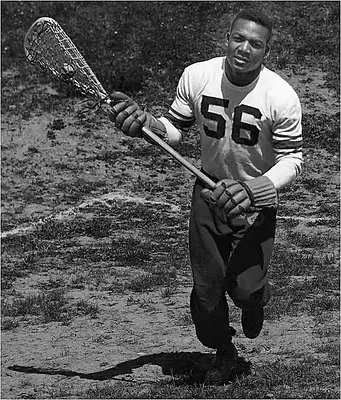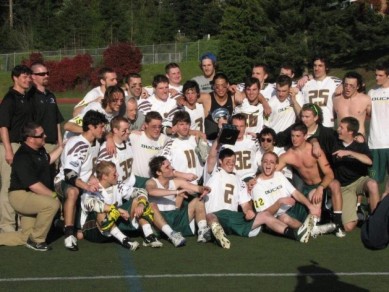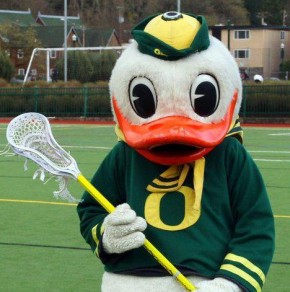It is difficult to find a school that has had more success across the entirety of its program than the University of Oregon over the past year. It may have been lost somewhere amidst a Rose Bowl victory, post-season tournaments and two national championships, but Oregon was also conference champs in another sport — lacrosse. Oregon lacrosse, a club sport for the men’s team and a member of the MPSF conference on the women’s side, set new records last year on their way to the MPSF crown.
A sport known for its entrenched status on so many college campuses, particularly on the east coast, lacrosse at Oregon shouldn’t be overlooked any longer.
Lacrosse began around 1100 AD in the northeast region of the US-Canada border by Native American/Canadian tribes. These people used the game as a way to pass the time, entertain, and give thanks to the surrounding royalty. Since then, lacrosse has transformed from a game of sticks and stones to a worldwide sport recognized at the collegiate and professional ranks of athletics.
Modern lacrosse requires full upper-body padding, a stick (shaft, head, mesh net), a 10-man squad (goalie, 3 defenders, 3 midfielders, 3 attackers), and a field, similar to football in size, topped by two 6 x 6 ft. goals. Women’s lacrosse uses slightly different sticks (tighter mesh) and doesn’t require any padding, because there is no aggressive physical contact allowed.
Variations to the game have given birth to different forms of the sport, ranging from youth to the professional level. Think of it basically as a combination of soccer and hockey, mixing the brutality and roughness of hockey with the finesse and speed of soccer.
Lacrosse is by far most popular in the eastern part of the United States, New York and Massachusetts in particular revere the game much like Oregon follows its football team. And did you know — the almighty Jim Brown’s best sport at Syracuse University was lacrosse, not football.
The sport’s popularity has risen dramatically in recent years, spreading westward over the past two decades. It remains most popular at the collegiate level, with about 60 NCAA Division 1 men’s teams and almost 90 Division 1 women’s teams, with hundreds more at the Division 2, 3, and club levels.
Lacrosse may not get anywhere near as much publicity as football at the University of Oregon, but the sport has its place at UO as well. The Oregon men’s team plays in the Men’s Collegiate Lacrosse Association in the PNCLL Division 1 conference at the club level, alongside schools such as Oregon State, Washington, and Boise State, while the women’s team is in an NCAA-sanctioned conference, the Mountain Pacific Sports Federation.
The men’s club team is comprised of mostly Oregon and Northern California high school stars. Since 2006, the Ducks have found themselves in the MCLA National Championship tournament every year except 2008 (2ndplace in 2007). They have also won three straight PNCLL conference titles since the MCLA created an end of season conference championship playoff during
the 2010 season. This recent success and recognition in the MCLA is generating a bit of a buzz on campus, even for a sport that still competes at a club level.
In great contrast to the men’s club team, this women’s team does not have a single athlete from the state of Oregon. Since joining the MPSF conference in 2003, the furthest an Oregon women’s lacrosse team had reached in prior years was the conference championship semifinal game.
That all changed in 2012. This spring, the Lady Ducks capped off a historic season falling just short of getting into the NCAA Championship tournament, led by Jana Drummond, who broke the all-time career scoring record at Oregon. The program won their first MPSF title, losing in OT in an NCAA tournament play-in game against Navy, hosted in Eugene.
Oregon received tremendous praise for what they had accomplished by the MPSF and women’s lacrosse community, and the outlook for the 2013 season looks very bright, as the team is only losing five seniors fielding a very young, but experienced squad.
The latest addition to Oregon’s wealth of facilities is a new lacrosse/soccer complex, now occupying space east of Autzen Stadium, with new locker rooms and seating for approximately 900.
While the impact of lacrosse at the University of Oregon may never broach the exposure and following of football, its success for both the men’s and women’s teams continue to seed the growth of the sport of lacrosse in Oregon at the youth and high school levels. Success breeds more success, and with the Ducks reaching high levels in the MCLA and MPSF, it helps to only inspire others to pick up a stick and give the sport a try.
Only a few years ago, it was hard to find gear, competition, let alone a place to play lacrosse in Oregon. Teams practiced where people weren’t playing baseball or soccer, and played games behind random elementary schools. Since those humble beginnings, things have improved drastically for youth lacrosse in Oregon.
Today, lacrosse is quickly becoming a standard spring sport — nearly on par with baseball. Playing lacrosse is becoming the new thing to try out in the spring. Kids are actually choosing to play lacrosse over baseball; the so-called “America’s Pastime.” The sport hit about 4,000 players in Oregon by 2007, and popularity of the sport has remained at a peak level since the Portland LumberJax had a brief stint in the NLL (National Lacrosse League).
In fact, after the 2010 youth season, THPRD, a leading youth sports organization, broke up a lot of the popular youth clubs in order to form high school “service” teams, meaning rather than playing for Beaverton Youth Lacrosse, kids now played under their pre-determined high school name.
This revised system structure is similar to how youth football or basketball works in Oregon. The change is having a positive effect on the sport’s growth, as now there is an immediate relationship between the youth and high school teams in a given area. This relationship is improving player skills, as the high school teams often host youth clinics, encouraging kids to play the sport for the long haul.
Lacrosse in the state of Oregon isn’t just rising in numbers, it’s rising in talent.
In 2010 at his annual camp, Ryan Powell, “the face of lacrosse,” spoke about the rise of lacrosse in Oregon:
 Is Lacrosse growing steadily in Oregon? And if so, do you see it slowing down?
Is Lacrosse growing steadily in Oregon? And if so, do you see it slowing down?
“Lacrosse in Oregon is blowing up. I don’t see the growth slowing at all in the near future either. We have the top lacrosse players in the state playing in our Rhino Lacrosse program. It is so exciting to see the way that the talent has risen in the state since the start of Rhino Lacrosse almost five years ago. We have just started to scratch the service with players having the opportunity to be recognized and recruited to play at some of the top Div. 1, 2, & 3 programs in the country.”
Awesome. Do you ever get calls from College coaches trying to find “That next big secret?
I do, it’s exciting for me to receive calls from some of the best lacrosse schools and top coaches, asking questions about the players in the Rhino program. There have always been some unbelievable athletes in Oregon, now with the combination of those abilities and some great coaching, players are starting to make some noise in the world of college lacrosse.
So what are the things you have going on to Showcase these Oregon Laxers?
This summer Rhino Lacrosse will field five HS select travel teams. Rhino Team Oregon, a.k.a.- The Black Rhinos, will be our most talented team and will be attending Champ Camp in Baltimore. I hope that college coaches find some time to check out any of our five HS squads this summer as we have some unknown talent rocking out here in the Pacific NW.
*Ryan Powell began holding camps and created a summer league (Rhino Lacrosse) in Oregon for youth and high school talent when he played for the Portland LumberJax.
Great youth programs feed high schools with great talent, leading to great in-state high school talent potentially fed into the University of Oregon lacrosse programs.
The growing popularity of lacrosse in Oregon follows a similar path to what happened in Colorado in the late 1990’s. Youth lacrosse expanded in Colorado in the ’80s and ’90s, paving the way for tremendous high school talent, as many players started heading back east to play Division 1 Lacrosse–the state was quickly becoming a hotbed. Colorado kids were thought of as a “steal” in the recruiting world by east coast coaches.
In the following years, leading up to 1999, the University of Denver, with successful club teams, worked with the NCAA to become the first school west of the Mississippi to have NCAA Division 1 lacrosse teams (men’s and women’s). One year later, the Air Force Academy’s lacrosse (men’s only) was elevated to the Division 1 level as well. Not coincidentally the Air Force Academy campus is located in Colorado.
The Lacrosse community already sees Oregon and California as the new hotbed — the rising West coast, if you will. Worst-case scenario, the men’s team eventually rises to non-varsity MCLA stardom, and the women’s team makes repeat trips to the postseason. It’s fair to assume this because of what happened in Colorado, with Oregon now following an eerily similar path.
For the men’s team to become a Division 1 team would be the ultimate goal, though Title IX scholarship limitations make this unlikely, unless additional women’s sports are added. Already Oregon has had to cut back on NCAA-affiliated men’s programs to adhere to Title IX parameters, cutting the highly successful wrestling program to make room for the reinstatement of baseball, while adding Acrobatics & Tumbling to even out the scholarship count (and becoming back-to-back national champions in the process).
Regardless, if the Oregon men’s program reaches the same NCAA-affiliated stature as the women’s team, it will not detract on the continued expansion of lacrosse, as the youth interest and undeniable support from the lacrosse community remains committed to the sport’s success in Oregon.
Track and Field will always be atop the list of spring sports at the U of O. But keep an eye out for lacrosse. It’s coming.
Related Articles:
Chip Kelly Update: Everything's Good Again ...
Chip Kelly Update: Wailing and Gnashing of Teeth
Shock and Awe -- The Oregon Ducks' Football Hangover Effect
Despite Lopsided Score, Georgia State "Never Stopped Believing"
Hope Springs Eternal for Ducks
Incompetent Pac-12 Officials: How Do You Miss ALL of THIS?
Joe Packer is a sophomore at the University of Oregon, majoring in Journalism. A Portland, Oregon native, he has been an avid Duck fan his whole life, attending his first of countless Duck football games at the age of 2. He played Lacrosse in high school, and today enjoys shooting hoops and a round of golf just about every day. As a player, referee, and youth sports coach, Joe looks to share his diverse perspective on the world of sports. He welcomes your feedback. Follow him on twitter: @JoePa_




